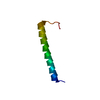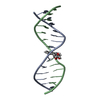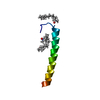[English] 日本語
 Yorodumi
Yorodumi- PDB-2kkg: NMR structure of the octarepeat region of prion protein bound to ... -
+ Open data
Open data
- Basic information
Basic information
| Entry | Database: PDB / ID: 2kkg | ||||||
|---|---|---|---|---|---|---|---|
| Title | NMR structure of the octarepeat region of prion protein bound to pentosan polysulfate | ||||||
 Components Components | Major prion protein | ||||||
 Keywords Keywords |  MEMBRANE PROTEIN / MEMBRANE PROTEIN /  prion protein / octapeptide repeats / pentosan polysulfate / sulfated glycans / prion protein / octapeptide repeats / pentosan polysulfate / sulfated glycans /  Cell membrane / Cell membrane /  Disulfide bond / Disulfide bond /  Glycoprotein / Glycoprotein /  Golgi apparatus / Golgi apparatus /  GPI-anchor / GPI-anchor /  Lipoprotein / Lipoprotein /  Membrane / Membrane /  Prion Prion | ||||||
| Function / homology |  Function and homology information Function and homology informationregulation of glutamate receptor signaling pathway / regulation of calcium ion import across plasma membrane / aspartic-type endopeptidase inhibitor activity /  glycosaminoglycan binding / regulation of potassium ion transmembrane transport / negative regulation of interleukin-17 production / negative regulation of dendritic spine maintenance / type 5 metabotropic glutamate receptor binding / cupric ion binding / negative regulation of calcineurin-NFAT signaling cascade ...regulation of glutamate receptor signaling pathway / regulation of calcium ion import across plasma membrane / aspartic-type endopeptidase inhibitor activity / glycosaminoglycan binding / regulation of potassium ion transmembrane transport / negative regulation of interleukin-17 production / negative regulation of dendritic spine maintenance / type 5 metabotropic glutamate receptor binding / cupric ion binding / negative regulation of calcineurin-NFAT signaling cascade ...regulation of glutamate receptor signaling pathway / regulation of calcium ion import across plasma membrane / aspartic-type endopeptidase inhibitor activity /  glycosaminoglycan binding / regulation of potassium ion transmembrane transport / negative regulation of interleukin-17 production / negative regulation of dendritic spine maintenance / type 5 metabotropic glutamate receptor binding / cupric ion binding / negative regulation of calcineurin-NFAT signaling cascade / negative regulation of interleukin-2 production / negative regulation of T cell receptor signaling pathway / cuprous ion binding / negative regulation of amyloid-beta formation / negative regulation of activated T cell proliferation / : / negative regulation of type II interferon production / positive regulation of protein targeting to membrane / side of membrane / glycosaminoglycan binding / regulation of potassium ion transmembrane transport / negative regulation of interleukin-17 production / negative regulation of dendritic spine maintenance / type 5 metabotropic glutamate receptor binding / cupric ion binding / negative regulation of calcineurin-NFAT signaling cascade / negative regulation of interleukin-2 production / negative regulation of T cell receptor signaling pathway / cuprous ion binding / negative regulation of amyloid-beta formation / negative regulation of activated T cell proliferation / : / negative regulation of type II interferon production / positive regulation of protein targeting to membrane / side of membrane /  inclusion body / cellular response to copper ion / neuron projection maintenance / protein sequestering activity / negative regulation of protein phosphorylation / molecular condensate scaffold activity / molecular function activator activity / positive regulation of protein localization to plasma membrane / protein destabilization / protein homooligomerization / inclusion body / cellular response to copper ion / neuron projection maintenance / protein sequestering activity / negative regulation of protein phosphorylation / molecular condensate scaffold activity / molecular function activator activity / positive regulation of protein localization to plasma membrane / protein destabilization / protein homooligomerization /  terminal bouton / cellular response to amyloid-beta / positive regulation of peptidyl-tyrosine phosphorylation / positive regulation of neuron apoptotic process / cellular response to xenobiotic stimulus / terminal bouton / cellular response to amyloid-beta / positive regulation of peptidyl-tyrosine phosphorylation / positive regulation of neuron apoptotic process / cellular response to xenobiotic stimulus /  signaling receptor activity / signaling receptor activity /  amyloid-beta binding / amyloid-beta binding /  microtubule binding / microtubule binding /  nuclear membrane / nuclear membrane /  protease binding / response to oxidative stress / amyloid fibril formation / learning or memory / protease binding / response to oxidative stress / amyloid fibril formation / learning or memory /  regulation of cell cycle / regulation of cell cycle /  membrane raft / copper ion binding / membrane raft / copper ion binding /  cell cycle / cell cycle /  dendrite / protein-containing complex binding / negative regulation of apoptotic process / dendrite / protein-containing complex binding / negative regulation of apoptotic process /  Golgi apparatus / Golgi apparatus /  cell surface / cell surface /  endoplasmic reticulum / identical protein binding / endoplasmic reticulum / identical protein binding /  plasma membrane / plasma membrane /  cytosol cytosolSimilarity search - Function | ||||||
| Biological species |   Mesocricetus auratus (golden hamster) Mesocricetus auratus (golden hamster) | ||||||
| Method |  SOLUTION NMR / SOLUTION NMR /  simulated annealing, simulated annealing,  molecular dynamics molecular dynamics | ||||||
| Model details | closest to the average, model 2 | ||||||
 Authors Authors | Taubner, L.M. / Caughey, B. / Copie, V. | ||||||
 Citation Citation |  Journal: J.Mol.Biol. / Year: 2010 Journal: J.Mol.Biol. / Year: 2010Title: Structure of the flexible amino-terminal domain of prion protein bound to a sulfated glycan. Authors: Taubner, L.M. / Bienkiewicz, E.A. / Copie, V. / Caughey, B. | ||||||
| History |
|
- Structure visualization
Structure visualization
| Structure viewer | Molecule:  Molmil Molmil Jmol/JSmol Jmol/JSmol |
|---|
- Downloads & links
Downloads & links
- Download
Download
| PDBx/mmCIF format |  2kkg.cif.gz 2kkg.cif.gz | 183.3 KB | Display |  PDBx/mmCIF format PDBx/mmCIF format |
|---|---|---|---|---|
| PDB format |  pdb2kkg.ent.gz pdb2kkg.ent.gz | 147.2 KB | Display |  PDB format PDB format |
| PDBx/mmJSON format |  2kkg.json.gz 2kkg.json.gz | Tree view |  PDBx/mmJSON format PDBx/mmJSON format | |
| Others |  Other downloads Other downloads |
-Validation report
| Arichive directory |  https://data.pdbj.org/pub/pdb/validation_reports/kk/2kkg https://data.pdbj.org/pub/pdb/validation_reports/kk/2kkg ftp://data.pdbj.org/pub/pdb/validation_reports/kk/2kkg ftp://data.pdbj.org/pub/pdb/validation_reports/kk/2kkg | HTTPS FTP |
|---|
-Related structure data
| Similar structure data |
|---|
- Links
Links
- Assembly
Assembly
| Deposited unit | 
| |||||||||
|---|---|---|---|---|---|---|---|---|---|---|
| 1 |
| |||||||||
| NMR ensembles |
|
- Components
Components
| #1: Protein | Mass: 8696.391 Da / Num. of mol.: 1 Source method: isolated from a genetically manipulated source Source: (gene. exp.)   Mesocricetus auratus (golden hamster) / Gene: PRNP, PRP / Production host: Mesocricetus auratus (golden hamster) / Gene: PRNP, PRP / Production host:   Escherichia coli (E. coli) / References: UniProt: P04273 Escherichia coli (E. coli) / References: UniProt: P04273 |
|---|
-Experimental details
-Experiment
| Experiment | Method:  SOLUTION NMR / Details: residues 57-91 of Syrian hamster prion protein SOLUTION NMR / Details: residues 57-91 of Syrian hamster prion protein | ||||||||||||||||||||||||||||||||||||||||||||||||
|---|---|---|---|---|---|---|---|---|---|---|---|---|---|---|---|---|---|---|---|---|---|---|---|---|---|---|---|---|---|---|---|---|---|---|---|---|---|---|---|---|---|---|---|---|---|---|---|---|---|
| NMR experiment |
|
- Sample preparation
Sample preparation
| Details |
| ||||||||||||||||||||||||||||||||||||||||||||||||||||||||||||||||||||||||
|---|---|---|---|---|---|---|---|---|---|---|---|---|---|---|---|---|---|---|---|---|---|---|---|---|---|---|---|---|---|---|---|---|---|---|---|---|---|---|---|---|---|---|---|---|---|---|---|---|---|---|---|---|---|---|---|---|---|---|---|---|---|---|---|---|---|---|---|---|---|---|---|---|---|
| Sample |
| ||||||||||||||||||||||||||||||||||||||||||||||||||||||||||||||||||||||||
| Sample conditions | pH: 5.0 / Pressure: ambient / Temperature: 298 K |
-NMR measurement
| NMR spectrometer | Type: Bruker DRX / Manufacturer: Bruker / Model : DRX / Field strength: 600 MHz : DRX / Field strength: 600 MHz |
|---|
- Processing
Processing
| NMR software |
| |||||||||||||||||||||
|---|---|---|---|---|---|---|---|---|---|---|---|---|---|---|---|---|---|---|---|---|---|---|
| Refinement | Method:  simulated annealing, simulated annealing,  molecular dynamics / Software ordinal: 1 molecular dynamics / Software ordinal: 1 | |||||||||||||||||||||
| NMR constraints | NOE constraints total: 285 / NOE intraresidue total count: 81 / NOE medium range total count: 59 / NOE sequential total count: 145 | |||||||||||||||||||||
| NMR ensemble | Conformer selection criteria: structures with the lowest energy Conformers calculated total number: 40 / Conformers submitted total number: 20 / Maximum lower distance constraint violation: 0 Å / Maximum upper distance constraint violation: 0.2 Å | |||||||||||||||||||||
| NMR ensemble rms | Distance rms dev: 0.99 Å |
 Movie
Movie Controller
Controller










 PDBj
PDBj

